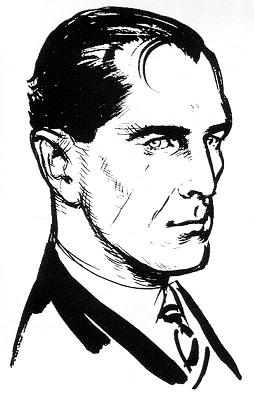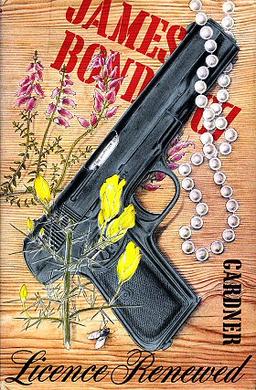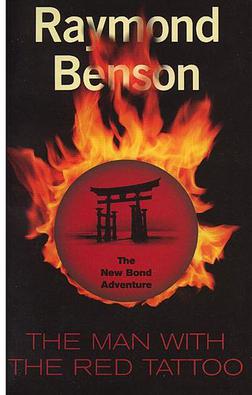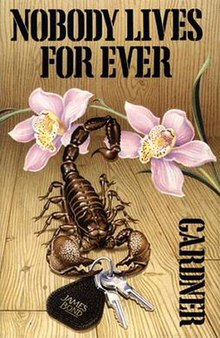
The James Bond series focuses on the titular character, a fictional British Secret Service agent created in 1953 by writer Ian Fleming, who featured him in twelve novels and two short-story collections. Since Fleming's death in 1964, eight other authors have written authorised Bond novels or novelisations: Kingsley Amis, Christopher Wood, John Gardner, Raymond Benson, Sebastian Faulks, Jeffery Deaver, William Boyd, and Anthony Horowitz. The latest novel is With a Mind to Kill by Anthony Horowitz, published in May 2022. Additionally Charlie Higson wrote a series on a young James Bond, and Kate Westbrook wrote three novels based on the diaries of a recurring series character, Moneypenny.

Q is a character in the James Bond films and novelisations. Q is the head of Q Branch, the fictional research and development division of the British Secret Service charged with oversight of top secret field technologies.

SPECTRE is a fictional organisation featured in the James Bond novels by Ian Fleming, as well as the films and video games based on those novels. Led by criminal mastermind Ernst Stavro Blofeld, the international organisation first formally appeared in the novel Thunderball (1961) and in the film Dr. No (1962). SPECTRE is not aligned with any nation or political ideology, enabling the later Bond books and Bond films to be regarded as somewhat apolitical. The presence of former Gestapo members in the organisation can be considered as a sign of Fleming's warnings about Nazi fugitives after the Second World War, as first detailed in the novel Moonraker (1954). In the novels, SPECTRE begins as a small group of criminals, but in the films it is depicted as a vast international organisation with its own SPECTRE Island training base capable of replacing the Soviet SMERSH.

Miss Moneypenny, later assigned the first names of Eve or Jane, is a fictional character in the James Bond novels and films. She is secretary to M, who is Bond's superior officer and head of the British Secret Intelligence Service (MI6).

A Bond girl is a character who is a love interest, female companion or (occasionally) an adversary of James Bond in a novel, film, or video game. Bond girls occasionally have names that are double entendres or sexual puns, such as Plenty O'Toole, Holly Goodhead, or Xenia Onatopp. The female leads in the films, such as Ursula Andress, Honor Blackman, or Eva Green, can also be referred to as "Bond girls". The term Bond girl may also be considered as an anachronism, with some female cast members in the films preferring the designation Bond woman.
Ian Fleming Publications is the production company formerly known as both Glidrose Productions Limited and Glidrose Publications Limited, named after its founders John Gliddon and Norman Rose. In 1952, author Ian Fleming bought it after completing his first James Bond novel, Casino Royale; he assigned most of his rights in Casino Royale, and the works which followed it to Glidrose.

Licence Renewed, first published in 1981, is the first novel by John Gardner featuring Ian Fleming's secret agent, James Bond. It was the first proper James Bond novel since Kingsley Amis's Colonel Sun in 1968. Carrying the Glidrose Publications copyright, it was first published in the United Kingdom by Jonathan Cape and in the United States by Richard Marek, a G. P. Putnam's Sons imprint.
In the 1950s and 1960s, Ian Fleming, creator of the fictional secret agent, James Bond, wrote a number of short stories featuring his creation that appeared in the collections For Your Eyes Only and Octopussy and The Living Daylights. Since 1997, several more short stories featuring Bond or set within the official James Bond universe have been published by authors who continued chronicling the world of Fleming's creation. The majority of these stories have, as of 2008, never been collected in book form, unlike the Fleming works. There are five exceptions: "Blast from the Past", "Midsummer Night's Doom" and "Live at Five" by Raymond Benson, "Your Deal, Mr. Bond" by Phillip and Robert King, and "Bond Strikes Camp" by Cyril Connolly which are discussed below.

Role of Honour, first published in 1984, was the fourth novel by John Gardner featuring Ian Fleming's secret agent, James Bond. Carrying the Glidrose Publications copyright, it was first published in the United Kingdom by Jonathan Cape and in the United States by Putnam.

Cold, first published in 1996, was the sixteenth and final novel by John Gardner featuring Ian Fleming's secret agent, James Bond. Carrying the Glidrose Publications copyright, it was first published in the United Kingdom by Hodder & Stoughton and in the United States by Putnam.

The Man with the Red Tattoo, first published in 2002, was the sixth and final original novel by Raymond Benson featuring Ian Fleming's character James Bond. Carrying the Ian Fleming Publications copyright, it was first published in the United Kingdom by Hodder & Stoughton and in the United States by Putnam. It was later published in Japan in 2003. The novel's working title was Red Widow Dawn.

You Only Live Twice is a 1967 spy film and the fifth in the James Bond series produced by Eon Productions, starring Sean Connery as the fictional MI6 agent James Bond. It is the first Bond film to be directed by Lewis Gilbert, who later directed the 1977 film The Spy Who Loved Me and the 1979 film Moonraker, both starring Roger Moore. The screenplay of You Only Live Twice was written by Roald Dahl, and loosely based on Ian Fleming's 1964 novel of the same name. It is the first James Bond film to discard most of Fleming's plot, using only a few characters and locations from the book as the background for an entirely new story.

Commander James Bond is a character created by the British journalist and novelist Ian Fleming in 1953. He is the protagonist of the James Bond series of novels, films, comics and video games. Fleming wrote twelve Bond novels and two short story collections. His final two books—The Man with the Golden Gun (1965) and Octopussy and The Living Daylights (1966)—were published posthumously.
The following outline is provided as an overview of and topical guide to James Bond:

James Bond is a line of spy thriller comic book titles by Dynamite Entertainment featuring the eponymous character originally created by Ian Fleming. It is licensed by Ian Fleming Publications and debuted in November 2015. Additional series and graphic novels are planned.











